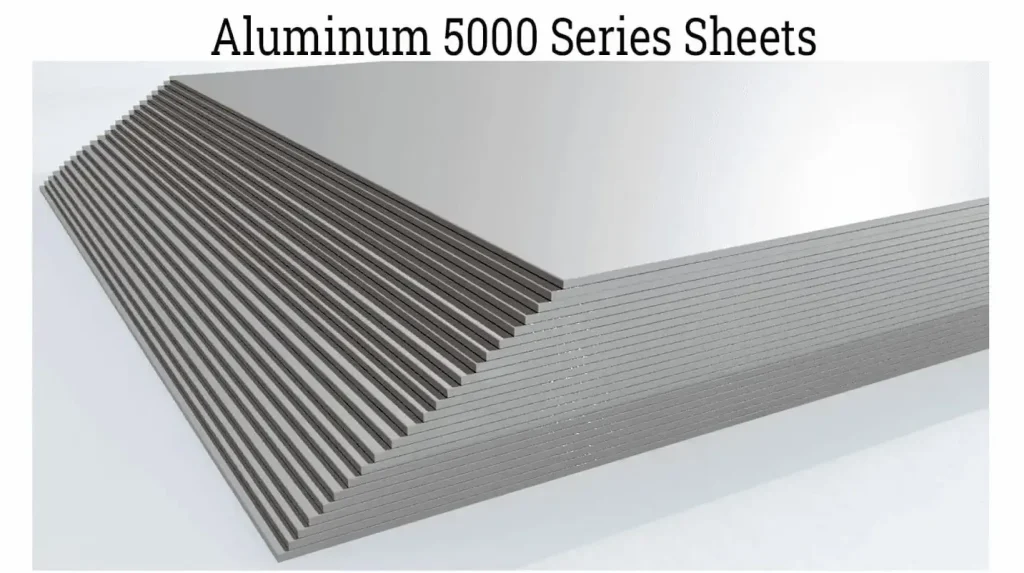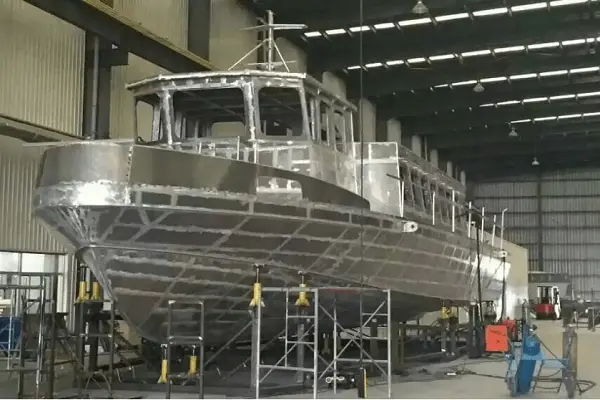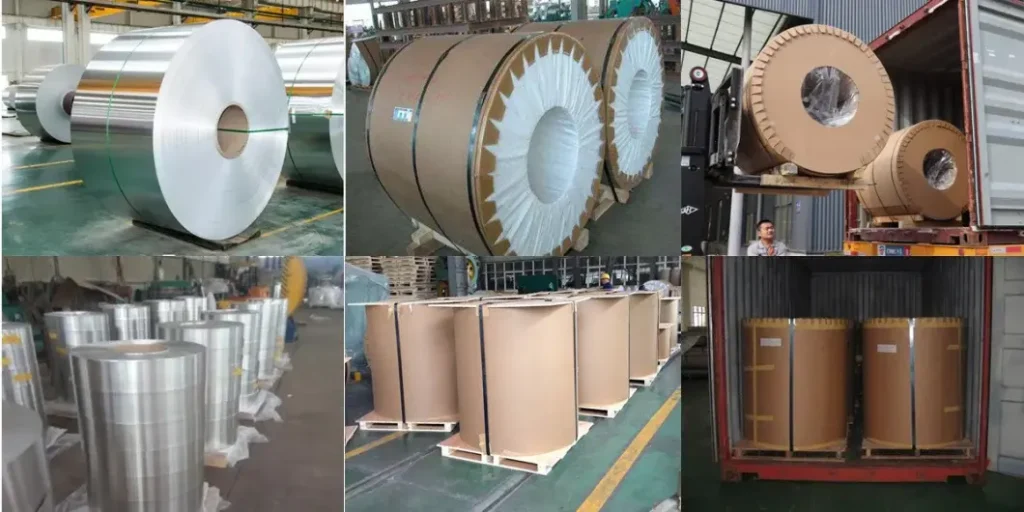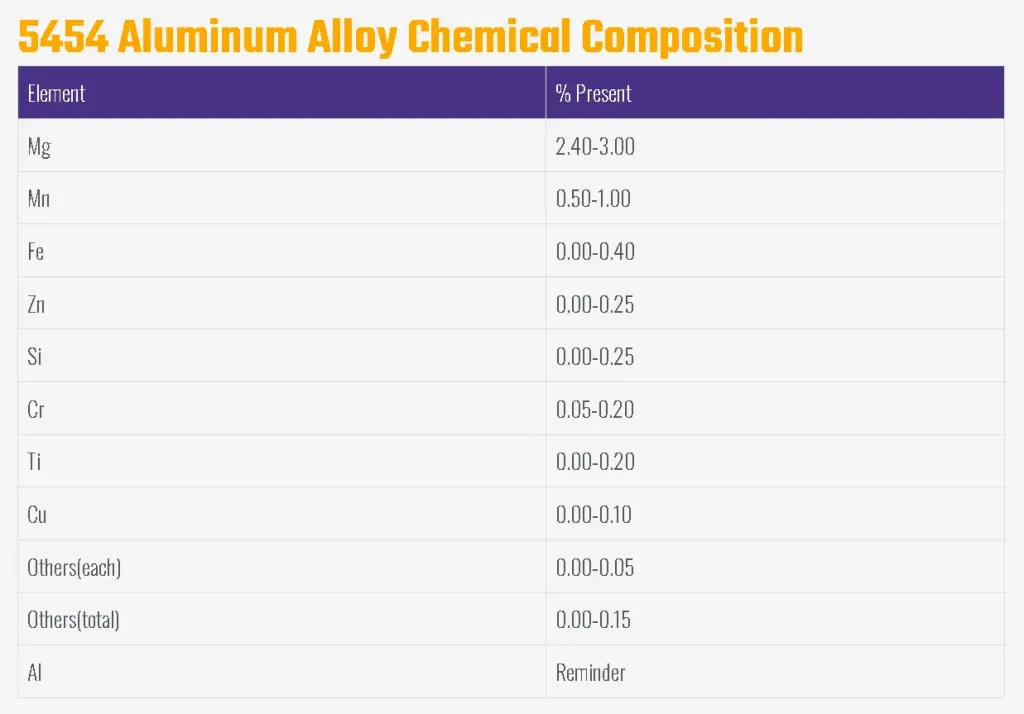
The 5000 series aluminum alloys
The 5000 series aluminum alloys are known for their unique characteristics that set them apart from other aluminum alloys. Its key factors make the 5000 series aluminum alloys different from other alloys.
1. Magnesium Alloying Element: The 5000 series aluminum alloys, including 5754, are primarily alloyed with magnesium. The addition of magnesium enhances the strength and hardness of the alloys, making them suitable for structural applications that require high strength.
2. Excellent Corrosion Resistance: The 5000 series aluminum offer remarkable corrosion resistance, particularly in marine and industrial environments. This corrosion resistance is due to the formation of a protective oxide layer on the surface of the aluminum, which helps prevent further oxidation and corrosion. The high corrosion resistance makes these alloys well-suited for applications exposed to saltwater, chemicals, and harsh atmospheric conditions.
3. Weldability: The 5000 series alloys exhibit good weldability, allowing for efficient and reliable joining processes. They can be easily welded using various techniques, including MIG (Metal Inert Gas) welding and TIG (Tungsten Inert Gas) welding. This characteristic facilitates the fabrication of complex structures and assemblies with these alloys.
4. Formability: The 5000 series aluminum, including 5754, offer excellent formability, enabling them to be easily shaped, bent, and formed into various designs and configurations. This formability makes them suitable for applications that require intricate components with specific shapes and dimensions.
5. High Strength-to-Weight Ratio: The 5000 series aluminum alloys have a high strength-to-weight ratio, which means they provide exceptional strength while remaining lightweight. This property is advantageous in industries such as automotive, aerospace, and transportation, where reducing weight is critical for fuel efficiency, performance, and load capacity.
6. Versatile Applications: Due to their unique combination of properties, the 5000 series aluminum alloys find numerous applications across various industries. They are commonly used in automotive components, marine structures, aerospace parts, architectural elements, industrial equipment, and more.
The 5000 series aluminum may have slightly different properties and characteristics, but collectively, they share these general attributes that differentiate them from other aluminum alloys.

Aluminum 5052: A Reliable and Versatile Alloy for Diverse Applications
The versatile and extensively used aluminum alloy 5052, also known as Al 5052, is renowned for having an exceptional balance of strength, formability, and corrosion resistance. Because of its exceptional performance in maritime conditions, this alloy is especially sought after. The main characteristics, attributes, and uses of aluminum 5052 will be covered in detail in this article.
Characteristics and Elements
Aluminum alloy 5052 is an alloy that may be treated without heat and is mainly made of aluminum, with small percentages of magnesium and chromium. These alloying components provide it special qualities that make it a desirable option for a range of uses.
1. Strength and Durability: Due to its good strength and durability, aluminum 5052 can tolerate harsh environments and large loads.
2. Excellent Corrosion Resistance: This alloy exhibits remarkable resistance to corrosion, making it highly suitable for marine and coastal applications. It resists saltwater, atmospheric corrosion, and a wide range of chemicals.
3. Formability: Aluminum 5052 has excellent formability, allowing it to be easily shaped, bent, and formed into intricate designs. It is often used for complex parts and components.
4. Weldability: This alloy demonstrates good weldability, facilitating efficient joining processes and enabling the fabrication of strong and reliable structures.
5. Surface Finish: Aluminum 5052 can achieve a smooth and aesthetically pleasing surface finish, making it suitable for decorative applications.
Applications
Aluminum 5052 is widely utilized in various industries due to its exceptional properties and versatility.
1. Marine and Shipbuilding: Aluminum 5052 is extensively used in the marine industry for boat hulls, decks, superstructures, and other marine components. Its corrosion resistance and durability make it ideal for prolonged exposure to saltwater environments.
2. Automotive: The alloy finds applications in the automotive industry for vehicle body panels, fuel tanks, and other structural components. Its lightweight nature contributes to improved fuel efficiency and reduced vehicle weight.
3. Architecture and Construction: Aluminum 5052 is employed in architectural applications such as roofing, facades, window frames, and interior design elements. Its corrosion resistance, formability, and aesthetic appeal make it a popular choice for modern construction projects.
4. Electrical Enclosures: The alloy is used in electrical enclosures and cabinets due to its excellent corrosion resistance and electrical conductivity. It provides protection for sensitive electrical components in various environments.
5. Food and Beverage Industry: Aluminum 5052 is utilized for food and beverage packaging, including cans, lids, and closures. Its corrosion resistance ensures the integrity and safety of packaged goods.
6. Industrial Equipment: The alloy finds applications in industrial equipment, including storage tanks, chemical processing equipment, and HVAC systems. Its corrosion resistance and durability make it suitable for harsh industrial environments.
Conclusion
Aluminum 5052, with its impressive strength, corrosion resistance, and formability, has established itself as a reliable and versatile alloy for a wide range of applications. Its prominence in marine, automotive, architectural, and other industries attests to its exceptional performance and adaptability. As industries continue to evolve, aluminum 5052 is expected to remain a vital material for various industrial and commercial applications.
Aluminum 5083: A Versatile Alloy for Diverse Applications
Aluminum alloy 5083, also known as Alu 5083, is a high-strength and corrosion-resistant aluminum alloy that offers exceptional versatility across a wide range of industries. Renowned for its excellent performance in marine environments, this alloy has found numerous applications beyond the maritime sector. In this article, we will explore the key features, properties, and applications of aluminum 5083.
Properties and Features
Aluminum alloy 5083 is primarily composed of aluminum, with trace amounts of magnesium, manganese, chromium, and other elements. These alloying elements contribute to its outstanding properties, making it a sought-after material for various demanding applications.
1. High Strength: Aluminum 5083 delivers impressive strength, allowing it to withstand heavy loads and harsh environments.
2. Excellent Corrosion Resistance: This alloy exhibits exceptional resistance to corrosion, particularly in marine and industrial environments, making it ideal for applications exposed to saltwater and corrosive chemicals.
3. Weldability: Aluminum 5083 offers good weldability, enabling efficient joining processes and facilitating the fabrication of complex structures.
4. Formability: The alloy can be easily formed through processes like rolling, bending, and extrusion, enabling the production of intricate shapes and designs.
5. Machinability: Aluminum 5083 demonstrates favorable machinability, allowing for efficient metalworking operations and precise fabrication.
Applications
Aluminum 5083 finds extensive applications across a diverse range of industries due to its exceptional properties.
1. Marine Industry: Aluminum 5083 is widely utilized in shipbuilding, boat hulls, and offshore structures due to its superior corrosion resistance in saltwater environments. Its high strength-to-weight ratio contributes to fuel efficiency and improved vessel performance.

2. Transportation: The alloy is employed in various transportation applications, including truck trailers, railway cars, and automotive parts. Its lightweight nature reduces overall vehicle weight, enhancing fuel economy and load capacity.
3. Aerospace: Aluminum 5083 is utilized in aerospace components such as aircraft wings, fuselage sections, and structural elements. Its high strength and corrosion resistance contribute to the safety and performance of aircraft.
4. Industrial Equipment: The alloy is employed in the construction of industrial equipment, including storage tanks, pressure vessels, and pipelines. Its corrosion resistance and durability are crucial in such demanding environments.
5. Architecture and Construction: Aluminum 5083 is used in architectural applications, such as building facades, roofing systems, and structural components. Its corrosion resistance, formability, and aesthetic appeal make it an ideal choice for modern construction projects.
6. Defense and Military: The alloy finds applications in defense-related equipment, including armored vehicles, naval vessels, and military aircraft components. Its high strength and resistance to ballistic impact make it suitable for demanding defense applications.
Conclusion
Aluminum 5083, with its remarkable strength, corrosion resistance, and versatility, has become an essential material in various industries. Its widespread usage in marine, transportation, aerospace, and other sectors showcases its reliability and adaptability. As technology advances, aluminum 5083 is expected to continue playing a crucial role in shaping the future of various industrial applications.
AW 5754 (EN AW 5754): A High-Strength Aluminum Alloy for Diverse Applications
AW 5754, also known as EN AW 5754, is a high-strength aluminum alloy that offers excellent mechanical properties, corrosion resistance, and weldability. This versatile alloy finds numerous applications across various industries. In this article, we will explore the key features, properties, and applications of AW 5754.
Characteristics and Traits
With magnesium serving as the main alloying element, AW 5754 is an aluminum-magnesium alloy. For demanding applications, this alloy’s special combination of qualities makes it appropriate.
Elevated Strength: AW 5754 is perfect for structural applications that need strength and dependability because of its high tensile strength and good resistance to deformation.
2. Corrosion Resistance: In situations that are industrial and marine, the alloy exhibits good corrosion resistance. It is more resilient since it can tolerate being exposed to chemicals, sea, and air.
3. Excellent Formability: AW 5754 may be readily molded, bent, and formed into intricate shapes due to its exceptional formability. Production of complex parts with exact specifications is made possible by this.
4. Weldability: The alloy exhibits good weldability, enabling efficient and reliable joining processes. It can be easily welded using various techniques, facilitating the fabrication of structures and assemblies.
5. Machinability: AW 5754 offers favorable machinability, allowing for efficient metalworking operations such as milling, turning, and drilling.
Applications
AW 5754 finds extensive applications in a wide range of industries owing to its exceptional properties and performance.
1. Automotive Industry: The alloy is used in the automotive sector for vehicle body panels, chassis components, and structural parts. Its high strength-to-weight ratio contributes to improved fuel efficiency and enhanced crash performance.
2. Transportation: AW 5754 is employed in the transportation industry for the construction of trailers, truck bodies, and railway cars. Its strength, corrosion resistance, and lightweight nature make it suitable for heavy-duty applications.
3. Marine and Offshore: The alloy is widely used in the marine and offshore sectors for boat hulls, ship superstructures, and offshore structures. Its corrosion resistance and strength ensure longevity and reliability in harsh marine environments.
4. Architecture and Construction: Applications for AW 5754 include roofing systems, facades, and structural elements in architecture and construction projects. It’s a desirable alternative because of its formability, resistance to corrosion, and aesthetic appeal.
5. Industrial Equipment: The alloy is used in process pipelines, pressure vessels, and storage tanks, among other industrial equipment. It is appropriate for demanding industrial applications due to its strength and resistance to corrosion.
6. Aerospace: AW 5754 is used in interior panels, wing components, and aircraft constructions, among other aerospace applications. Its superior strength and low weight make it more fuel-efficient and performs better.

In Summary
Because of its excellent strength, resistance to corrosion, formability, and weldability, AW 5754 (EN AW 5754) has emerged as a popular aluminum alloy used in a variety of industries. Its wide range of applications, from automotive to marine, highlights its versatility and reliability. AW 5754 is expected to continue playing a significant role in shaping the future of diverse industrial sectors.

Commonly Known Alloys within 5000 Series Aluminum
The 5000 series aluminum alloys encompass several individual alloys, each with its own specific composition and properties. Here are some commonly known alloys within the 5000 series:
1. 5005: Aluminum alloy 5005 is primarily alloyed with magnesium. It offers good corrosion resistance, formability, and weldability. It is often used for architectural applications, building facades, and decorative elements.
2. 5052: Alloy 5052 is one of the most widely used alloys in the 5000 series. It contains magnesium and has excellent corrosion resistance, high strength, and good formability. It finds applications in marine environments, automotive components, and general sheet metal fabrication.
3. 5083: Aluminum alloy 5083 is alloyed with magnesium, manganese, and chromium. It is known for its exceptional corrosion resistance, high strength, and excellent performance in marine environments. It is commonly used for boat hulls, superstructures, and other marine applications.
4. 5086: Similar to alloy 5083, 5086 is also highly corrosion-resistant and commonly used in marine environments. It offers good weldability and is often employed in shipbuilding, boat hulls, and offshore structures.
5. 5754: Alloy 5754 contains magnesium and has excellent corrosion resistance, high strength, and good formability. It is widely used in automotive components, transportation equipment, and architectural applications.
6. 5182: Aluminum alloy 5182 is alloyed with magnesium and offers good corrosion resistance and formability. It is commonly used for beverage can lids, caps, and other packaging applications.
7. 5454: Alloy 5454 is primarily alloyed with magnesium and has good corrosion resistance and high strength. It finds applications in the automotive industry, pressure vessels, and structural components.

These are just a few examples of the commonly known alloys within the 5000 series aluminum. Each alloy within the series has its own specific properties and applications, but collectively, they share the general characteristics of high strength, corrosion resistance, formability, and weldability that make the 5000 series alloys highly versatile and widely used in various industries.


